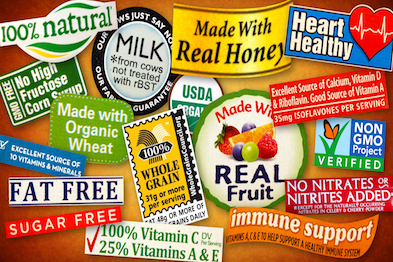Buyer Beware!

What if I told you the food industry often puts labels on foods that are not only misleading, but some are outright lies? Well, sugar-free, low-fat, and fat-free often aren’t any of these. Take sugar-free for example. Just because a food is labeled “sugar-free” that doesn’t mean there is absolutely no sugar in it. The term sugar free actually means there is less than 0.5 grams of sugar per serving according to FDA guidelines. In my book, 0.5 grams of sugar is still sugar! So, if that is the case, then what does “no sugar added” mean? This is a product that already contains a naturally occurring sweetener just nothing has been added by the manufacturer to make it any sweeter.
Another example, “all natural.” This food label is quite vague. You may think it means the food is healthy, but that’s not necessarily true. In fact, it’s not easy to even say what it means. The FDA actually doesn’t have an official definition for the use of the term “natural.” However, they do allow food companies to use the term if the food has no added color, artificial flavors, or synthetic substances.
Next, let’s take “low-fat,” and “fat-free.” There’s a lot of confusion associated with the label “fat-free.” Just like with sugar free foods, fat free really means there is less than 0.5 grams of fat per serving, according to the FDA. So not really fat free, is it? So then what are low fat foods? This can be just as confusing. When it comes to foods that claim to be low in fat, what it means is that the product contains 3 grams of fat or less per serving. Reduced fat means the product contains at least 25% less fat than the full-fat version of the food. Lots of wordplay here, so that is why it’s important to be careful about fat claims when analyzing a food label. If you don’t pay attention, you could end up consuming a food that is full of fat and were even talking about the bad fats! According to U.S. News and World Report, “The FDA allows any food with .5 grams of trans fat or less to claim “0 grams trans fat” on the label. If you happen to eat several servings or a few different ‘trans fat-free’ foods during a day, you can wind up consuming a measurable amount, which leads to increased levels of artery-clogging, bad (LDL) cholesterol. Don’t be fooled! Check the ingredient list, and if you see “hydrogenated” or “partially-hydrogenated oil” listed, step away from the package.”
In the end my advice to you is when reading food labels remember that old saying, “caveat emptor.” Buyer Beware! Always read food labels with a certain amount of skepticism.





